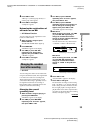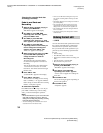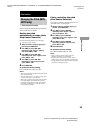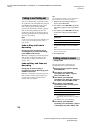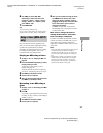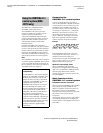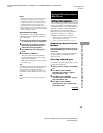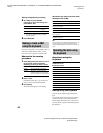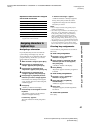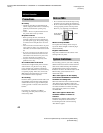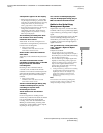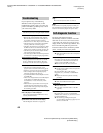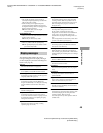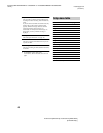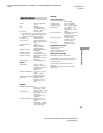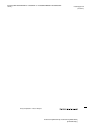
Additional Information
filename[\\WIN-48\NAKAYAMA 3-1\4233926121 3.14\423392612MDSJE770U2\GB05OPE-
U2.fm]
43
model name1[MDS-JE770] model name 2 [MDS-JE470]
[4-233-926-12(1)]
masterpage:Left
(3 column)
“Group Full!” appears in the display
•
When the Group function is on, “Group Full!”
may be displayed if editing is performed. This
means there are insufficient characters for group
management. Delete any unnecessary disc
names, group names or other characters.
•
Even when the Group function is off, the group
management information is updated
automatically when Move, Divide and other
editing operations are performed, so “Group
Full!” may be displayed.
The remaining recording time does
not increase even after erasing
numerous short tracks
Tracks under 12 seconds
1)
in length are not
counted and so erasing them may not lead to an
increase in the recording time.
1) During stereo recording.
In MONO or LP2 mode: about 24 seconds
In LP4 mode: about 48 seconds
Some tracks cannot be combined
with others
Tracks may not be combined if they have been
edited.
The total recorded time and the
remaining recordable time on the MD
may not total the maximum
recording time
Recording is done in minimum units of
2 seconds
1)
each, no matter how short the
material is. The contents recorded may thus be
shorter than the maximum recording capacity.
Disc space may also be further reduced by
scratches.
1) During stereo recording.
In MONO or LP2 mode: about 4 seconds
In LP4 mode: about 8 seconds
Tracks created through editing may
exhibit sound dropout as you are
searching for a point while
monitoring the sound.
Track numbers are not marked
correctly
Incorrect assignment or marking of track
numbers may result when CD tracks are divided
into several smaller tracks during digital
recording. Also, when the Automatic Track
Marking is activated during recording, track
numbers may not be marked as in the original,
depending on the program source.
The correct recorded/playing time
may not be displayed during play of
MDs recorded in monaural mode.
Guide to the Serial Copy
Management System
Digital audio components, such as CDs, MDs,
and DATs, make it easy to produce high-quality
copies of music by processing music as a digital
signal.
To protect copyrighted music sources, this deck
uses the Serial Copy Management System,
which allows you to make only a single copy of
a digitally recorded source through digital-to-
digital connections.
You can make only a first-generation
copy
1)
through a digital-to-digital
connection.
Examples are as follows:
•
You can make a copy of a commercially
available digital sound program (for example, a
CD or MD), but you cannot make a second copy
from the first-generation copy.
•
You can make a copy of a digital signal from a
digitally recorded analog sound program (for
example, an analog record or a music cassette
tape) or from a digital satellite broadcast
program, but you cannot make a second copy
from the first-generation copy.
1) A first-generation copy means the first recording
of a digital audio source through the deck’s
digital input connector. For example, if you
record from a CD player connected to the
DIGITAL IN connector, that copy is a first-
generation copy.
Note
The restrictions of the Serial Copy Management
System do not apply when you make a recording
through the analog-to-analog connections.



